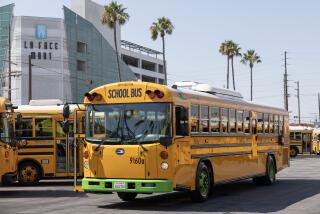One Schoolâs Wish List Is Long, Complex
Asked what President Bush could do for schools, the sixth grade students in Becki Robinsonâs class at First Street Elementary School were quick with answers. They would like more computers, new reading books, grass on the playground, even a swimming pool.
Ask their principal and teachers what Bush could do and the list grows longer and more complex.
Though heartened by the spotlight on schools cast by Bushâs historic education summit with all 50 governors in Charlottesville, Va., the faculty at this East Los Angeles school were skeptical about the policy makersâ willingness to back up their words with enough dollars and flexibility to make a difference.
Want Idea to âTrickle Upâ
They also wondered if the increasingly popular concept of power-sharing with teachers and parents--which is now being tried in the Los Angeles school district--would âtrickle upâ to the highest echelons of government.
Bush, said bilingual teacher Leticia Yniguez-Gomez, should establish âa real education committeeâ with teachers and administrators who understand the problems. âThe money has always been kept from us because we have to explain what our needs are to people who donât understand. Thatâs why weâve never been able to run with the ball.â
At the summit, Bush and the governors agreed on six major objectives for educators: to reduce illiteracy and dropouts, make schools drug-free, ease restrictions on use of federal education money, promote early childhood education, restructure schools and prepare students for the work force.
Question of Spending
Although many national education leaders said they hoped that Bush would agree to spend more federal money on education, the meeting did not produce such a call.
âI plan to urge my fellow governors not to simply look upon the summit as a forum to request greater federal funding,â Gov. George Deukmejian said, echoing the views of many governors. âWe should respond to the education challenge with creativity and flexibility, and not seek all our answers through greater funding.â
Supt. of Public Instruction Bill Honig said that few could quarrel with the summit goals. He urged adoption of a number of âhigh pay-off investments,â such as in teacher training and team-building among teachers, parents and administrators.
At First Street, more than 90% of the students come from families on welfare, more than half of the pupils need help learning English and test scores lag below national averages. But Principal Betty Morin said that every year she and her faculty face tough spending decisions because of budget cuts and inflation. Hands-on instructional materials that help students see what they need to learn, such as calculators and counting blocks for math, have been among the chief casualties of the spending reductions.
Morin said that she doesnât believe more money is always the answer to educationâs woes. But, if the federal government is going to ask more of schools, then it is obligated to spend more on them, she said. This year, only 9.7% of the districtâs nearly $4-billion budget comes from the federal government.
Robinson, who has taught at First Street for 20 years, agreed. âIf they are asking us to do something we cannot do now, then we need more resources--and the ability to restructure what we have--to meet the needs of our students.â
Better Off Than Many
Her room is, she said, better stocked than many classrooms in the district. But much of the equipment and supplies are âthings I bought myself, or that I begged, borrowed and stole, or that were castoffs from other teachers,â she said.
The class had one computer for 26 students--and it was broken.
âThere shouldnât be any reason why I should have to pay for things out of my own pocket,â she said.
More to Read
Sign up for Essential California
The most important California stories and recommendations in your inbox every morning.
You may occasionally receive promotional content from the Los Angeles Times.











